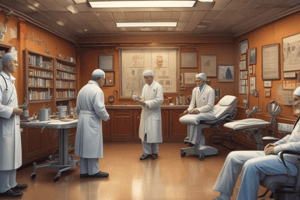Podcast
Questions and Answers
What is important to do when taking a patient's history?
What is important to do when taking a patient's history?
- Divide your attention between the patient and other tasks
- Have a colleague assist you
- Give the patient your whole attention (correct)
- Take notes on your phone
Why is it important to avoid taking shortcuts during history taking?
Why is it important to avoid taking shortcuts during history taking?
- To ensure accurate information (correct)
- To reduce patient wait times
- To avoid patient complaints
- To save time for other tasks
What should be done while taking the History of Present Illness?
What should be done while taking the History of Present Illness?
- Write down the history without asking the patient
- Ask the patient leading questions
- Get the patient to tell the story in his own fashion (correct)
- Skip this part and go to the next section
Why is it important to get the patient's story in their own words?
Why is it important to get the patient's story in their own words?
What should you prioritize when taking a patient's history?
What should you prioritize when taking a patient's history?
What should you assess while taking the History of Present Illness?
What should you assess while taking the History of Present Illness?
What comes after 'Course and progress' in the given sequence?
What comes after 'Course and progress' in the given sequence?
What is the result of giving a patient your whole attention during history taking?
What is the result of giving a patient your whole attention during history taking?
What should you avoid while taking the History of Present Illness?
What should you avoid while taking the History of Present Illness?
Why is it important to maintain focus during history taking?
Why is it important to maintain focus during history taking?
What is the fourth item in the sequence?
What is the fourth item in the sequence?
What is the goal of taking a thorough History of Present Illness?
What is the goal of taking a thorough History of Present Illness?
What is the last item in the sequence?
What is the last item in the sequence?
What is the second item in the sequence?
What is the second item in the sequence?
How many items are there in the sequence?
How many items are there in the sequence?
What is examined in the neck during an examination?
What is examined in the neck during an examination?
What is checked for in the neck during examination?
What is checked for in the neck during examination?
Where are the Lymph Nodes examined?
Where are the Lymph Nodes examined?
What is NOT examined in the neck during an examination?
What is NOT examined in the neck during an examination?
Why is the neck examined?
Why is the neck examined?
What type of information can be gathered through palpation?
What type of information can be gathered through palpation?
What is NOT assessed during palpation?
What is NOT assessed during palpation?
What aspect of palpation is related to the feeling of warmth or coolness?
What aspect of palpation is related to the feeling of warmth or coolness?
What is the aspect of palpation that involves assessing movement or function?
What is the aspect of palpation that involves assessing movement or function?
Which of the following is a physical characteristic assessed through palpation?
Which of the following is a physical characteristic assessed through palpation?
Flashcards are hidden until you start studying




